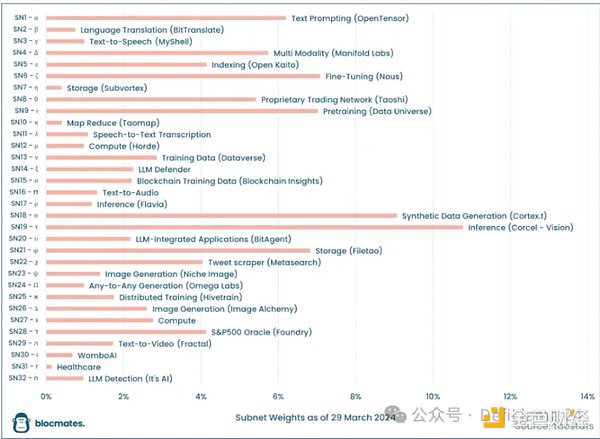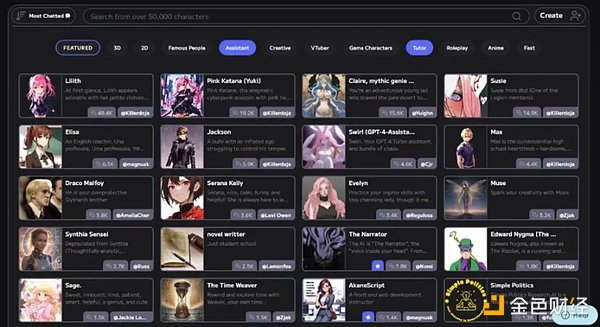Author: Riyue Xiaochu
The AI sector is different from all other sectors. Because AI is not only the AI of the currency circle, but also the AI of all mankind. AI is vigorously changing human society. Maybe in a few decades, our descendants will call it the fifth industrial revolution of artificial intelligence.
For a long time in the future, AI will be the biggest focus of mankind. It will also be a hot spot in the currency circle.
Since the advent of GPT3.5, the ability of AI has shocked the whole world, and it will also affect the currency circle. The release of GPT3.5 in 2023 and the release of Sora in 2024 have both triggered hype in the AI sector of the currency circle. Now, the giants are carrying out a technology competition to compete for the right to speak in the future of AI. All fields of human society are using AI to innovate industries.
So there will definitely be projects worth tens of billions of dollars in the AI track. Of course, there are also a large number of projects in this track that want to take advantage of the hot spots to reap a wave. So we need to have a keen eye to pick out truly valuable blockchain AI projects. The following are the important directions I think:
1 Decentralized AI network
The significance of decentralized AI network is 1) to prevent centralized giants from having too much power 2) It is also the right to group ideas and aggregate excellent small and medium-sized teams.
Bittensor is a decentralized AI network. Anyone can produce competitive digital goods on it. These digital goods can be machine intelligence, storage space, computing power, protein folding, financial market predictions, etc., and receive TAO rewards.
The architecture of Bittensor can be divided into two layers. The bottom layer is a blockchain based on Polkadot Substrate, which is responsible for executing the consensus mechanism and incentivizing the network. The AI layer is responsible for reasoning, training, and ensuring input/output compatibility between Bittensor protocol nodes.
The core of Bittensor is subnets. Subnets are a competitive market. Anyone can create a subnet, or participate in an existing subnet. You create a subnet by paying a registration fee (in TAO). Subnets will compete with each other to achieve survival of the fittest. The current subnets include large language models, fine-tuning models, language translation, data, etc.
For detailed information about the subnets, please refer to: https://foresightnews.pro/article/detail/57931

2 Decentralized computing power
In the AI track, decentralized computing power must have a seat, and it is a very important seat. The three major elements of AI are data, algorithm model and computing power, and only computing power belongs to hardware. General hardware needs to follow Moore's Law, that is, the performance doubles every 18 months to meet market demand. However, we are now in the era of AI for all mankind. The AI competition among technology giants and the implementation of applications have led to a huge demand for GPUs. The supply of computing power is obviously unable to meet the explosive growth in AI demand. The core value of the decentralized computing power platform lies in using blockchain technology to gather idle AI computing power around the world to meet the market's demand for GPUs.
At the same time, the problem of which came first, the chicken or the egg, can also be solved in the currency circle. By taking advantage of the expectation of token airdrops, a large amount of computing power can be attracted to enter the project at the beginning, and tokens can be used to incentivize after the launch. We are accustomed to this set of gameplay, but the reality is that this kind of gameplay can only be done in the currency circle.
Another advantage is that compared with the GPU service of the cloud center, the use of the decentralized computing power platform does not require very complicated contract process review, etc. There is also an advantage in the use price, which is only about 1/5 ~1/10.
Arkash and Render are veteran players in this field, each with its own advantages. However, in terms of the number of GPU connections, the two new players Aethir and io.net have far surpassed them. According to layergg data, Aethir has more than 40,000 GPUs, and io.net has more than 22,000. The number of GPUs for Arkash and Render is only in the hundreds or thousands.

In terms of market value, io is only 260 million US dollars, and fdv is 2.2 billion US dollars. ATH has 320 million US dollars, and FDV is 3.5 billion US dollars. However, unlike other high FDVs, a large proportion of io and net are mining outputs, which are used for mining rewards for decades. Excluding this part, io's fdv is 1.3 billion US dollars, and ATH's FDV is 1.7 billion US dollars.
3 AI's Web3 platform
In addition to the general large language models of giants, there are still a lot of practical needs that are not met. For example, a data-sensitive industry (such as medical and education industries, etc.), the company's accumulated market experience, the professional knowledge of teachers or experts, and the algorithms optimized to solve specific problems.
These needs have two basic demands: one is to protect data or knowledge, and the other is to obtain economic returns. The blockchain-based AI platform can perfectly meet these two needs.
KIP Protocol is a secure and efficient decentralized Web3 underlying protocol that provides AI creators (data owners, algorithm model makers, AI application developers) with
1) Data/knowledge ownership guarantees. They are stored on the chain in the form of ERC-3525 semi-homogeneous tokens to represent the ownership of knowledge assets and token door access rights. They are solely controlled by the owner.
2) Data/knowledge usage protection. KIP Protocol is the world's first Web3 protocol that supports decentralized RAG (Retrieval Augmented Generation) solutions. RAG is a complex innovative technology used in generative AI that enables AI models to generate answers that they did not know by retrieving data and information from external knowledge bases and databases.
3) Application layer of AI. Creators can easily access the path of their works through KPI, as well as build front-end code and promote their products. Anyone can easily use various AI applications on the KIP platform. At the same time, a set of transparent and anonymous web3 contracts are used to record the usage of various applications, which is open and transparent
4) Settlement layer. KIP uses account abstraction to allow users to participate in and use multiple applications without signing multiple gas. Tokenization in the form of ERC-3525 SFT is then used to record and settle transactions between users and token owners associated with each element they interact with. Settlement can be done without borders using KIP platform tokens.
On the 17th, KIP Protocol announced a milestone partnership with Moemate. Moemate uses the KIP protocol to build decentralized infrastructure. This partnership will introduce more than 3 million users to Web3.
Moemate is a leading AI agent platform that allows users to create customized AI companions such as chatbots, discord/telegram robots, artificial intelligence NPCs with adjustable personalities, multi-language support, and voice cloning and image generation. Games, virtual companions, and even AR/VR fields.

4 Real human protection
With the development of artificial intelligence, AI is no different from real people. It is not only reflected in language expression, but also in pictures (including photos of people), videos, etc. On the Internet, you can no longer distinguish whether the account is a real person or an artificial intelligence. Therefore, a serious problem may arise in the future: how to prove that you are a real person on the Internet? At the same time, we also need to distinguish between real people and AI on the Internet and monitor the potential adverse effects of AI in a timely manner. Then blockchain technology can be used as a proof of real identity. It can encrypt and store biometric information and ensure that it cannot be tampered with, and it can also be used to prove the real person without leaking details.
On this issue, Sam Altman, the founder of OpenAI, first proposed it, and it founded Worldcoin, which aims to establish a global digital identity and financial network owned by humans. Global registration of each individual is achieved through Orb biometric scanning to reliably distinguish between humans and machines. Worldcoin creates Layer2 with Op stack, and all human biometric information will use Zero Knowledge Proof (ZKP technology) to ensure privacy, and no third party will directly obtain it. The incentive mechanism of the protocol uses a dedicated blockchain token called WLD. However, from the perspective of the secondary market, the circulation of WLD is 800 million US dollars, and the FDV is as high as 28 billion US dollars. Therefore, it is not suitable for long-term holding, and it is only considered to be held when the AI sector is hyped again.
 Bernice
Bernice









